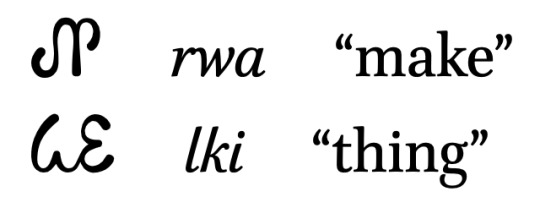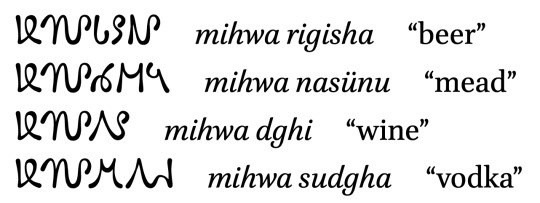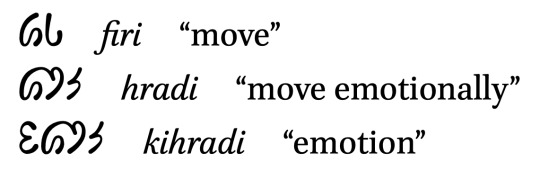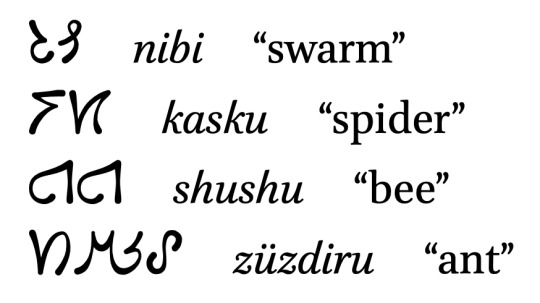they/them • a conlang sideblog! my main blog is levuna • i’m also on youtube and bluesky • (this blog used to be at @mindutme)
Don't wanna be here? Send us removal request.
Text
I just noticed a funny thing about this example which illustrates some of the weirdness of Valya orthography: the same glyph is used for fwi in müfwirdu and vü in tsivünga!
The glyph itself is a ligature of the glyphs for vu and i. Depending on the location of stress, the Proto-Valya sequence vui had two outcomes: either /vu.ˈi/ → /vwi/ → /fwi/, or /ˈvu.i/ → /vuj/ → /vy/ (vü). With tsivünga (“again”), the situation is slightly more complicated because the word comes from a phrase, tsivi fünga (“at a new time”), with a bit of haplology merging the vi and fü syllables. Except ... that same glyph is also used for the syllale fü, because (due to a historical accident), Modern Valya doesn’t use a ligature of fu and i. So the word fünga alone (“new” or “young”) is also spelled with this same glyph!

word of the day: dli
Today’s Valya word is dli, meaning “come.”

Two days ago I was going to make an example sentence that involved the word “shape,” but I didn’t have that yet so I decided to push the example to the next day. So yesterday I made a word for shape from rwa “make�� (“give shape to”), and then realized I did already one: mazi. It was even a Lexember word! So I kept the derivation but gave it a new meaning, and moved on. (Yes, it could have been a synonym, but I thought the new meaning made more sense for that etymology anyway.)
Today I was just going to show that example sentence, but I decided to expand it a bit, and found that I would need a new word, for real this time. So that’s dli, “to come.” I probably should have had that already, anyway! When used with tsivünga “again,” it means “come back.”
One other thing to know before the example sentence is that Valya has a glyph shaped like V, which is for the syllable pa, and another shaped like Ʌ, which is for du. The latter shows up within ligatures both in Thursday’s word fwirdu and also in today’s word (*duli in Proto-Valya).
Tünitya tüka müfwirdu rwa kimazi “pa,” ba tüdli tsivünga mu rwa kimazi “du.” Geese fly away in a V-shape and come back in a Ʌ-shape.

9 notes
·
View notes
Text
word of the day: dli
Today’s Valya word is dli, meaning “come.”

Two days ago I was going to make an example sentence that involved the word “shape,” but I didn’t have that yet so I decided to push the example to the next day. So yesterday I made a word for shape from rwa “make” (“give shape to”), and then realized I did already one: mazi. It was even a Lexember word! So I kept the derivation but gave it a new meaning, and moved on. (Yes, it could have been a synonym, but I thought the new meaning made more sense for that etymology anyway.)
Today I was just going to show that example sentence, but I decided to expand it a bit, and found that I would need a new word, for real this time. So that’s dli, “to come.” I probably should have had that already, anyway! When used with tsivünga “again,” it means “come back.”
One other thing to know before the example sentence is that Valya has a glyph shaped like V, which is for the syllable pa, and another shaped like Ʌ, which is for du. The latter shows up within ligatures both in Thursday’s word fwirdu and also in today’s word (*duli in Proto-Valya).
Tünitya tüka müfwirdu rwa kimazi “pa,” ba tüdli tsivünga mu rwa kimazi “du.” Geese fly away in a V-shape and come back in a Ʌ-shape.

9 notes
·
View notes
Text

I haven’t stopped on the new conlang, but I did basically start it from scratch because I have specific ideas of what it should be and I haven’t yet hit that mark.
It was always supposed to be a magic language, so there should be no native speakers, and thus the barrier of entry to learn magic is quite high. Most users would memorize spells, not knowing the inner machinations that allow one to make new spells.
It’s been quite a challenge moving my thought patterns away from naturalist language, it’s such a departure from anni for me. But I think this marks a definite shift in progress.
On the left- a spell to envenom a blade. By cutting someone with this blade it transforms a small amount of their blood into poison.
On the right- a spell to cause a blade to glow with moon light.
41 notes
·
View notes
Text
youtube
My latest youtube video is up! It’s this post again, but on youtube this time: a translation of the titular poem from Ursula K. Le Guin’s The Left Hand of Darkness into Sdefa. Please enjoy!
8 notes
·
View notes
Text
word of the day: rüni
Today’s Valya word is rüni, meaning “tool.”

Rüni is a pretty general word; though it most often refers to tools, it can refer to pretty much anything human-made. That’s because it’s derived from rwa, “to make,” via the participle-forming suffix -ni. Changes since the time of Proto-Valya have obscured this relationship, both in terms of the sounds of the words and also the meaning. There’s also the word lki “thing,” which is broader still, including naturally-occurring inanimate objects.

Klakufu lu rüni pa ngu kufu ki, ba klatanu lu rüni pa ngu tanu ki. A cart is a thing you pull, and a building is a thing you build.

7 notes
·
View notes
Text
word of the day: fwirdu
Today’s Valya word is fwirdu, meaning “goose.”

The most common goose found on Dzu is the Canada Goose, though other species have occasionally made an appearance. Despite there being no known land south of Dzu, the island’s population of geese flies south every autumn and returns the following spring.
There are other migratory birds that spend time on Dzu, but geese are maybe the most recognizable. For this reason, one version the Valya word for “south” is named for them: difwirdu, “with (the) goose,” though there is also ditya “with (the) bird.”

Other birds that have Valya names so far include dwihwa, hawk; dwihwanti, turkey vulture (lit. “false hawk”); gyukyu, grackle; hlünu, grosbeak; kara, sparrow; ldrati, catbird; matasi, owl; and vasi, blue jay.
8 notes
·
View notes
Text
word of the day: mihwa
Today’s word is mihwa, meaning “beer” or “alcohol.”

The word originally meant “beer” specifically, but has since broadened in meaning to include other alcoholic drinks. It’s often used in compounds, to specify what kind of alcohol is meant. That could be mihwa rigisha, “wheat alcohol,” to specify beer; mihwa nasünu, “honey alcohol,” for mead; mihwa dghi, “grape alcohol,” for wine; or miwha sudgha, “potato alcohol,” for vodka. I think that covers all the alcoholic drinks I know of that I can describe with Valya vocabulary as it stands now, but my knowledge of alcohol is pretty limited so there might be other options, too.
If you already know which kind of alcohol is being talked about, you could just say mihwa for any of them. Without context, it’s probably still “beer,” but if there’s a cup of mead on the table then you can be pretty sure that’s what’s meant. The singular form can refer to a glass, bottle, or other unit of a drink as well as referring to the drink in general.

13 notes
·
View notes
Text
Jessie Peterson very first foray into conlanging as a young child involved scrambling up English words into different words. She called her “language” Ishglen. Decades later she decided to explore what it might mean to redo the original experiment as an actual conlang, and she’s written up the results for Fiat Lingua.
47 notes
·
View notes
Text
The Straits and the Southwest Corner
Twin lighthouses, Tôqhaw Lam and Pok, are found at each end of the strait known as Tôlman, "Fog Turn," where ships from the south turn into the Inner Sea. Lôkh i-Mûn, Warning Island is nearly midway between the prongs of Tiptum at the entrance to the Sea. The fog that rolls in at night vanishes by noon without ever touching the ground, leaving the sun with perfect clarity for the rest of the day. Following the glow, ships from the Outside dock safely for the night at Tôlman, have their cargo inspected by Tepat in the morning, and wait for the clarity of afternoon to round the point into the Inner Sea. Such is the whole west coast, south and north of it.
South of the straits is the desert peninsula Pet. Despite the millions of water droplets hanging over it each morning, this is the driest region of Tiptum. Some plants do actually grow here, all of these which are efficiently exploited by the native Heiepe, who inhabited the peninsula before it was colonized by Tepat in its attempt to control shipping through the strait.

The ubiquitous ground cover, in distant patches, is needle grass (Yuktepat: /khut-chut/), which fends off all foragers with stiff, sharp-pointed leaves. Brave humans have nevertheless collected it in order to sew clothes. Other residents include the only slightly more appetizing spiky fatleafs (/ti-yôp-phuk/) and bladeleafs (/ti-yôp-lam/). The fatleafs’ bulbous leaves are covered with short thorns that spiral upward toward the tip of the leaf. Every few years they produce flowers on a single tall stalk. Those patient enough to gather the leaves and cut off the thorns can eat them, or pulp them to make juice or beer. Bladeleafs’ leaves are nested within each other, with edges so sharp the natives have used dried ones as hunting weapons. The Heiepe make bowls out of the clustered plant leaves, which they cover with cloth and set outside at night. The fog condenses in the cloth and the leaves as dew, by which the people obtain a very useful substance known as water.
The southwest desert areas of Tiptum are typically dry and receive little rain, but are affected by neighboring tropical weather systems. The region receives most of its precipitation in brief and sudden torrents from west-moving tropical storms that begin in the Inner Sea. These storms often dissipate when they reach the desert, but sometimes they reform and gain strength on the other side of the ocean, swelling into hurricanes that end up blasting the coasts of Aipura and Tricunia.
19 notes
·
View notes
Text
word of the day: rigisha
Today’s word is rigisha, meaning “wheat.”

Last week I said that wheat or something very similar was eaten by Valya speakers, but that I don’t know the exact variety or its name yet. I still don’t know the former, but I do now know the word is rigisha, [ri.ɡi.ça]. This is probably a somewhat broad term, anyway; I imagine there are a few different varieties or species cultivated on Dzu.
Not only is wheat used to make noodles (klakwahla and küfüli, wide and thin noodles respectively), but also some sort of bread, and beer (both yet to be named). The word sarigisha means “flour.” It’s literally “wheat stuff,” using the same initial element found in sashu “wax” (“bee stuff”), saksa “maple syrup” (“maple stuff”), safli “seawater” (“sea stuff”), and even sanüri “reason” (“idea stuff”).

10 notes
·
View notes
Text
word of the day: nasünu
Today’s Valya word is nasünu, meaning “honey.”

A few posts ago I said that maple syrup is the primary sweetener used on the island Dzu. I’m going to amend that slightly and say that honey is also commonly used. Let’s say there are some regions where maple syrup is the main one, and other regions where it’s honey—maybe you could even draw a dividing line between “honey Dzu” (dzu nasünu) and “maple syrup” Dzu (dzu saksa). My hunch is that the highland regions might be the maple syrup area, though I don’t really know for sure. That would match the following example sentence, which (as usual, unless I specify otherwise), is in the highland dialect of Valya:
Tsulya ra pa nasünu hlira ra sabghu saksa, zu susu ra sumbaru krintsi dvala ha? /tsuʎ.ʎa ra pa na.sy.nu ɬi.ra ra sab.ʀu sak.sa | zu su.su ra sum.ba.ru kr̥in.tsi dva.la ha/ Will you make me move if I say I like honey more than maple syrup?

7 notes
·
View notes
Text
no word of the day post today because i’m traveling (ra kwismurwa) and I’m tired (ra münwi kimblu). i’ll have one tomorrow (kitni nwa)!
9 notes
·
View notes
Text
word of the day: hraha
Today’s word is hraha, meaning “be quiet” or “be still.”

Hraha comes from the negation of Proto-Valya *firai, “to move.” While *firai became firi, *firai-ha became hraha. From the physical meaning of “not move,” it expanded to “not make a sound,” i.e. “be quiet.” You can also just negate firi, of course, but that would only mean “not move,” not “be quiet.”
Meanwhile, the meaning of firi has expanded in a different direction, now meaning “change” as well. Another derivation from firi, hradi, has changed from “move” (physically, in the transitive sense) to “move emotionally,” so from that comes the word kihradi, “emotion.”

10 notes
·
View notes
Text
word of the day: tüfazi
Today’s Valya word is tüfazi, meaning “breathe.”

From this word you get ksütüfazi, meaning “animal”—literally, “breathing thing.” This word isn’t actually all that common, though, as one would more likely use a more specific word: pru for a larger animal, kuküma for a mammal (with some exceptions), ninimbani for a bug, and so on. Instead, ksütüfazi is an overarching term that is used when one wants to recognize or point out the commonalities of all animals. Ksütüfazi is also the only one of these words that includes humans.
Another, less obvious, derived word is tfashi, “breath.” To say that something or someone is alive, tfashi is used with the verb rwa “make”: Mu rwa tfashi, “They are alive,” lit. “They make breath”—but, depending on context, this could also be “They create life.”

8 notes
·
View notes
Text
word of the day: ninimbani
Today’s word is ninimbani, meaning “insect.”

Ninimbani is the diminutive of nimbani, which itself originates as the diminutive of mbani! Mbani is an obsolete word meaning something like “swarmer,” related to the verb nibi “to swarm.” So nimbani, previously *ni-nibaini, meant “little swarmer,” but as the language changed it became less obvious that it was a diminutive word, and the reduplication was reapplied to make ninimbani. These days, the middle steps of mbani and nimbani are largely forgotten, but ninimbani and nibi are still in common use.
Nibi was originally a more neutral word meaning “gather,” but in Modern Valya its association with insects and sometimes other animals has led to it being used less frequently for people. Instead, the word huta, originally “tie” or “join together,” has gained an intransitive meaning of “assemble” or “gather.” You can use nibi to refer to animals gathering, but to do so for people would be a bit rude. It’s also still used to mean “accumulate” or “accrete,” for both inanimate and intangible subjects.
The word ninimbani doesn’t match exactly with the English word “insect,” as it also includes kasku, the spider. However, social insects, like shushu, the bee, and züzdiru, the ant, are more prototypical examples.

17 notes
·
View notes
Text
word of the day: vangwumütu
Today’s Valya word is vangwumütu, meaning “raccoon.”

Translated literally, it means “the two black eyes.” I think the reason for that is self-explanatory. Because the word originates as a dual noun (and still is one, transparently so), the plural forms drop the dual prefix va- and replace it with mu- (for the definite plural) or li- (for the indefinite plural).
Bipa lbagza mungwumütu shüdi mupya tu duhra? /bi.pa‿l.ba.ɡza mu.ŋwu.my.tu çy.di mu.pja tu du.r̥a/ Why do raccoons dunk their food in water before eating?

10 notes
·
View notes
